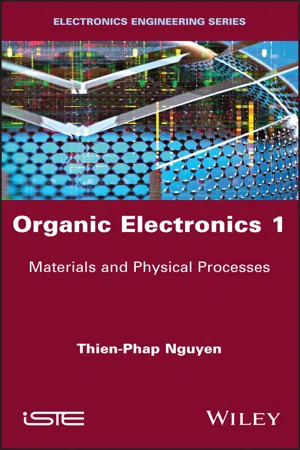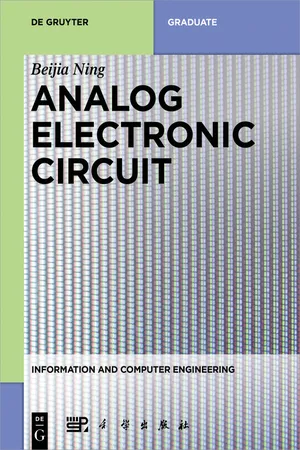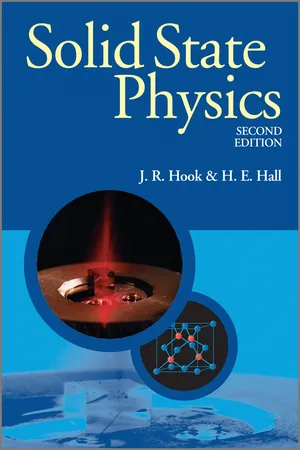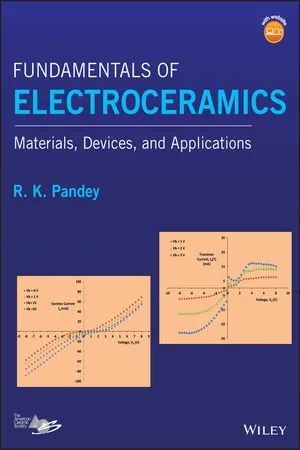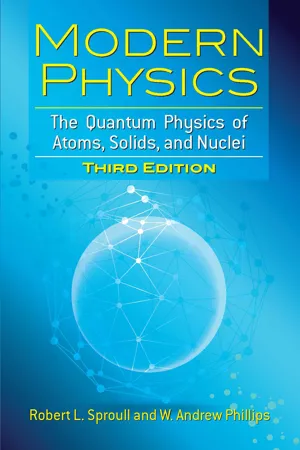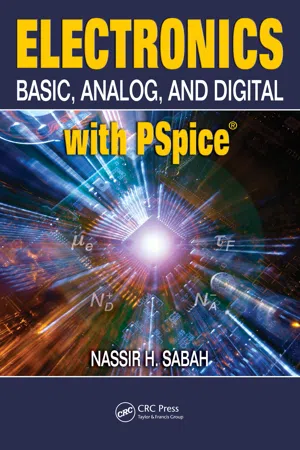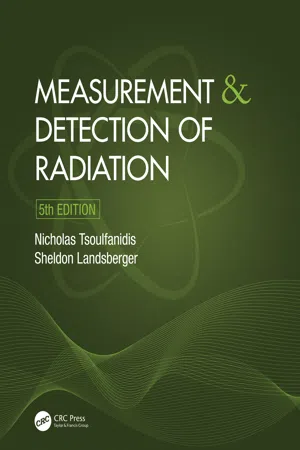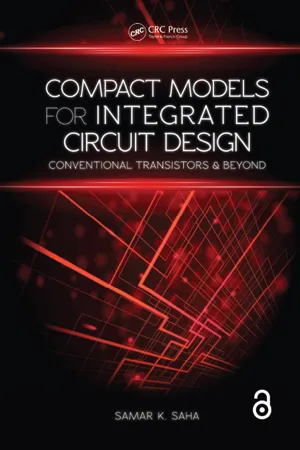Technology & Engineering
p type Semiconductor
A p-type semiconductor is a type of semiconductor material that has been doped with elements that introduce positively charged "holes" into the crystal lattice. This creates a surplus of positive charge carriers, which are responsible for the conduction of electric current in p-type semiconductors. When combined with n-type semiconductors, p-type semiconductors are used to create diodes and transistors in electronic devices.
Written by Perlego with AI-assistance
Related key terms
Related key terms
1 of 4
Related key terms
1 of 3
12 Key excerpts on "p type Semiconductor"
- eBook - ePub
Organic Electronics 1
Materials and Physical Processes
- Thien-Phap Nguyen(Author)
- 2021(Publication Date)
- Wiley-ISTE(Publisher)
1 Semiconductor TheoryThis chapter provides a brief overview of the basic concepts of semiconductor theory with regard to particular physical characteristics that allowed the creation of electronic components that would revolutionize various technologies starting in the middle of the 20th Century. We will now describe the operation of P–N junctions, which are the essential components for the creation of electronic devices. This basic knowledge will then allow us to address physical processes in organic materials and then to understand the operation and use of devices based on new organic semiconductors.1.1. Introduction
In electronics, the basic materials are semiconductors (SCs). They differ from metals in their dependence on the temperature of their electric characteristics. Essentially, when the temperature increases, the resistivity of metals increases, while the resistivity of SCs decreases. The theoretical contributions made by quantum mechanics allowed the electrical properties of SCs to be studied and explained based on the theory of energy bands. Unlike metals, in which the charge carriers are electrons, SCs can also carry positive charges, known as holes, that contribute to the electrical conductivity of these materials. The concentration of the carriers can also be changed by “doping”, that is, the incorporation of the selected impurities in a determined quantity. This process not only allows the conductivity of the SC to be changed, but also favors the transport of one type of charge carrier at the expense of the other. An SC is characterized as N-type if the majority of the carriers are electrons and as P-type if the majority of the carriers are holes.The combination of an N-type and P-type SC is a P–N junction, which is the fundamental element of all traditional electronic components. The assembly of these elements, prepared with other materials, makes it possible to create components that perform special functions, and the design of the circuits with these components leads to multiple applications of various different types. - eBook - ePub
- Geoff Lewis(Author)
- 2013(Publication Date)
- Routledge(Publisher)
intrinsically pure tetravalent semiconductor elements (I type material) with trivalent or pentavalent impurities in a precisely controlled way, pseudo-semi-conduction can be produced by the careful combination of the Group III (trivalent) and Group V (pentavalent) elements to produce a new class of device with even more useful characteristics. By adding pentavalent impurity atoms to I type material, additional electrons are donated to the crystal structure. This forms an N type semiconductor material in which electrons form the majority current carriers.In a similar way, the addition of trivalent impurities leaves spaces or holes in the crystal structure which represent energy levels where electrons could exist. This P type material thus has the positive charges of the holes as majority carriers. A hole therefore has an equal but opposite polarity charge to that of an electron. In both P and N type materials there will always be some thermally generated charges of the opposite polarity and these are known as minority carriers.In certain applications, the P and N type impurity layers may be doped to a relatively higher or lower level than normal. By convention, these regions would be indicated as P+ or N+ ; or P– or N–, respectively.If a surface of a mono-crystalline P type material is heated to about 1100°C and exposed long enough to a gaseous atmosphere of N type impurity, the surface will be converted into N type. Therefore, somewhere below the surface, there will exist a junction on an atomic scale, between the P and N type materials. Holes and electrons will migrate across this junction to produce an electric field described as the barrier potential. When this reaches some particular level (about lOOmV for Ge and 600 mV for Si), the region becomes depleted of free current carriers to produce a barrier or depletion region as indicated in Fig. 32.1 . If an external voltage greater than the barrier potential, is now applied to this junction with a positive polarity on the P region (forward bias), current will flow through the junction and in the external circuit. If the applied voltage is reversed, the barrier potential is reinforced and very little current flows (reverse bias). This current would in fact fall to zero if it were not for the thermally generated hole-electron pairs that act as minority carriers. Operated in this way, the PN junction thus has diode characteristics which, in many cases, can conveniently be considered simply as a piecewise - eBook - ePub
- Beijia Ning, Beijia Ning(Authors)
- 2018(Publication Date)
- De Gruyter(Publisher)
2Semiconductor diodes and their applicationsNow that both n - and p -type materials are ready here, we are only one step away from the first solid-state electronic device, the semiconductor diode, with its simplicity and wide range of applications, showing its importance for the development of modern solid-state devices.2.1p -n junctionBy simply joining an n -type and a p -type material together, nothing more, just the joining of one material with a majority carrier of electrons to one with a majority carrier of holes, a p -n junction is created with its special conductivity. Simply speaking, a p -n junction is a piece of semiconductor material in which part of the material is p -type and part is n -type [1 ].As shown in Fig. 2.1 (a) , at the junction, the donated electrons in the n -type material, also called majority carriers, diffuse into the p -type material, as it is known that diffusion often occurs from an area of high density to an area of lower density. The situation is the same in the p -type material: the majority carriers, holes, move across the junction into the opposite side. So, the holes and electrons are combined in the region near the junction, resulting in a lack of free carriers. Once the free carriers have become neutral, only positive and negative ions remain, as shown in Fig. 2.1 (b) . So, an electric field is set up from positive ions to negative ions, which prevents the movement of majority carriers to the opposite sides [9 ].When balance is reached, a region of uncovered positive and negative ions is generated. This region is called the depletion region, for the reason of “depletion” of free carriers in the region. Across the junction, potential difference exists, which is called the contact potential [10 –12 ].Fig. 2.1: - eBook - ePub
- J. R. Hook, H. E. Hall(Authors)
- 2013(Publication Date)
- Wiley(Publisher)
CHAPTER 6
Semiconductor devices
I find television very educating. Every time somebody turns on the set I go into the other room and read a book.—Groucho Marx6.1 INTRODUCTION
The use of semiconductors in electronics is probably the biggest contribution of solid state physics to twentieth century technology. To understand the great majority of semiconductor devices it is necessary to consider the behaviour of charge carriers near a surface or interface. Of particular importance are the boundary between an n-type region and a p-type region, the boundary between a semiconductor and an insulator, and the boundary between two different semiconductors. In this chapter we consider devices using these three possibilities. Our emphasis will be on understanding the physics of the devices, not the technical applications.6.2 THE p–n JUNCTION WITH ZERO APPLIED BIAS
A boundary between p and n regions can be produced in a number of ways. The deposition of a thin layer of donor impurities on the surface of a p-type semiconductor, followed by a controlled period of time at a high temperature to allow diffusion of the donors into the substrate, creates an n-type region near the surface where the donors outnumber the original acceptors. A p–n junction can also be produced by epitaxial growth (section 6.6) on a p-type substrate of material containing donor impurities. Both of the above methods can of course alternatively create an acceptor-rich region in contact with an n-type substrate. Other methods also exist for producing a region of semiconductor in which a changeover from p-type to n-type behaviour occurs on a short length scale.The useful behaviour of a p–n junction results from the effect on the electron energy levels in the region of the junction as shown in Fig. 6.1 . The energy levels are shown as a function of position only, and no distinction is made between different k values; electrons in the conduction band are indicated schematically by full circles and holes in the valence band by open circles. The factor controlling the relative positions of the levels on the two sides of the junction is the necessity for a uniform chemical potential; this is the condition for thermal equilibrium between two or more systems when particles can move freely between them (see Mandl,2 chapter 8). In the case of a p–n junction the equilibrium is achieved by a small transfer of electrons from the n region to the p region, where they annihilate with holes, leaving a region with very few free carriers† near the junction, known therefore as the depletion layer (Fig. 6.2(b )). The positively charged ionized donors in the n region of the depletion layer and the negatively charged ionized acceptors in the p region leave the n region positively charged and the p region negatively charged (Fig. 6.2(c )). This results in the lowering of electron energy levels on the n side and the raising on the p side, shown in Fig. 6.1 , which causes the chemical potential to be position-independent as required; remember that Fig. 6.1 is a diagram of electron - eBook - ePub
- David Wyatt, Mike Tooley(Authors)
- 2018(Publication Date)
- Routledge(Publisher)
2.3). These gaps are referred to as holes. Once again, current will flow when an external potential difference is applied to the material. Regardless of whether the impurity element produces surplus electrons or holes, the material will no longer behave as an insulator, neither will it have the properties that we normally associate with a metallic conductor. Instead, we call the material a semiconductor – the term simply indicates that the substance is no longer a good insulator nor a good conductor but has the properties of something between the two! Examples of semiconductors include germanium (Ge) and silicon (Si). The process of introducing an atom of another (impurity) element into the lattice of an otherwise pure material is called doping. When the pure material is doped with an impurity with five electrons in its valence shell (i.e. a pentavalent impurity) it will become an N-type (i.e. negative type) material. If, however, the pure material is doped with an impurity having three electrons in its valence shell (i.e. a trivalent impurity) it will become P-type material (i.e. positive type). N-type semiconductor material contains an excess of negative charge carriers, and P-type material contains an excess of positive charge carriers. 2.1.1 Temperature effects As explained in Chapter 1, all materials offer some resistance to current flow. In conductors the free electrons, rather than passing unobstructed through the material, collide with the relatively large and solid nuclei of the atoms. As the temperature increases, the nuclei vibrate more energetically, further obstructing the path of the free electrons, causing more frequent collisions - eBook - ePub
Fundamentals of Electroceramics
Materials, Devices, and Applications
- R. K. Pandey(Author)
- 2018(Publication Date)
- Wiley-American Ceramic Society(Publisher)
Eq. 7.3 ).7.3There are many possible ways in which holes can be created in the valence band and electrons pushed into the higher energy states of the conduction band. Temperature is one such agent; the other agents could be radiation of appropriate photon energy, ionizing radiation and by introducing electrons and holes by the process called doping. Doping is the most used method in practice. Once doped, the material is classified as extrinsic semiconductor material of which there are two types: one being the n‐type and the other p‐type.To facilitate the understanding of these two types of semiconductors, let us consider the conductivity Eq. 7.3 . There are three components of conductivity: the total conductivity (σnet ), the electron conductivity (σe ), and the hole conductivity (σp ). If σe > σp , the material is classified as an n‐type semiconductor. Similarly a p‐type material is the one for which σp > σn .Whether it is an n‐type or a p‐type material, it plays a crucial role in determining their usefulness in technology.Doping is the process in which we either introduce dopants in an intrinsic semiconductor either thermally or by ion implantation. When we add an electron, the host material accepts extra electrons in its lattice making it richer in electrons and its conductivity then is primarily because of the negatively charged electrons. Therefore, the converted material becomes an n‐type semiconductor. Similarly, the dopants that rob electrons from the host material makes it a p‐type material and its conductivity is primarily because of the positively charge holes. Now the question is how we accomplish doping mechanism in practice? Chemistry here comes to our help. For example, we know that Si is found in Group IV of the periodic table and therefore, it is called tetravalent atom meaning that it has four electrons in its outermost orbit (or valence electrons). It can be made n‐type simply by doping it with an element from Group V. Group V elements are pentavalent, and in the process of doping, they can give up one electron to the Group IV elements to complete the task of converting it to an electron‐rich atom. Similarly, elements of Group III can be used to convert a Group IV semiconductor to a p‐type material. With respect to the host semiconductor of Group IV atoms, atoms of Group V are called donors, and those of Group III the acceptors. Now we can ask ourselves once again what is the mechanism through which the acceptors or donors can accomplish their assigned tasks? This is done by a process called ionization. When an element loses or gains an electron, we call the process ionization, and the energy involved in the process is called the ionization energy. For example, when we dope Si with antimony (Sb), the associated ionization energy is 39 meV. Similarly, ionization energy of 57 meV is involved when the dopant is Al. In Table 7.4 - eBook - ePub
Modern Physics
The Quantum Physics of Atoms, Solids, and Nuclei: Third Edition
- Robert L. Sproull, W. Andrew Phillips, W. Andrew Phillips(Authors)
- 2015(Publication Date)
- Dover Publications(Publisher)
Although this procedure seems complicated, it is simpler than many used in practice, where a very large number of steps are often required to produce the integrated circuit. Finally the disc is cut up into individual circuits, or chips.10-6 THE p-n JUNCTION
A p-n junction is an internal boundary between n-type and p-type regions of a simple crystal. It cannot be formed by pressing together a p-type and an n-type semiconductor, as such a boundary would have too large a concentration of imperfections to have interesting electrical properties. Instead it must be prepared by techniques similar to those used in the preparation of MOS devices.As a result of the large concentration gradient at the boundary between the p- and n-type regions, electrons diffuse from the n- to the p-type region, leaving behind positively charged donor atoms. In a similar way holes diffuse from the p- to the n-type, and the resulting double layer of charge sets up an electric field. This field produces a drift current that eventually balances the diffusion current and gives a potential difference across the junction. The magnitude of this built-in potential ϕ is related to the electron concentrations in the n- and p-type semiconductors, nn and np , respectively. Since the total electron current is zero,where the signs are reversed with respect to eq. 10-15 because the charge on the electron is –e. Integrating across the junction,where the Einstein relation has again been used. For a junction between n-type silicon with a concentration of arsenic atoms of 1022 m-3 and p-type silicon with 1020 m-3 boron atoms,This voltage cannot be measured by connecting a voltmeter across the junction. If it could, then the p-n junction could be used as an inexhaustible power source, which is clearly contrary to the principle of conservation of energy. In fact, opposing junction potentials are set up between the n- and p - eBook - ePub
Electronics
Basic, Analog, and Digital with PSpice
- Nassir H. Sabah(Author)
- 2017(Publication Date)
- CRC Press(Publisher)
A over the temperature range of interest and is much greater than the concentration of electrons.Concept: Over the temperature range of practical interest, the type and concentration of current carrier in an extrinsic semiconductor are determined by the type of dopant and its concentration.In other words, the current carriers in an extrinsic semiconductor can be predominantly positive or negative electric charges whose concentrations can be varied over a wide range. This gives great flexibility to semiconductor devices and underlies their practical importance.2.4 Electrochemical Potential
A characteristic feature of semiconductors is that the current can be a drift current due to an applied electric field, as in metals, or a diffusion current due to differences in carrier concentrations in different parts of the semiconductor. There is no diffusion current in metals, because the conductivity is so high that any concentration gradients result in large currents that immediately eliminate these gradients. The analysis of systems having both electric potential and concentration gradients is greatly facilitated by the concept of electrochemical potential.Expression for Chemical Potential
Atomic particles, such as atoms, electrons, or holes that are free to move in a given medium, will move from regions of high concentration to regions of low concentration. A region that contains a given particle at a higher average concentration than adjacent regions will gradually expand due to random thermal motion of the particle. If a drop of a water-soluble dye, for example, is deposited in a glass of water, the dye spreads by diffusion until it is uniformly distributed throughout the glass. When this happens, the same number of dye particles, on average, will move per unit area per unit time in any specified direction. - eBook - ePub
- Nicholas Tsoulfanidis, Sheldon Landsberger(Authors)
- 2021(Publication Date)
- CRC Press(Publisher)
Figure 7.17 ). The n-type semiconductor has a high electron concentration; the p-type has a high hole concentration. Electrons will diffuse from the n- to the p-type; holes will diffuse in the opposite direction. This diffusion will produce an equilibrium of electron and hole concentrations, but it will upset the original charge equilibrium. Originally, either a p-type or an n-type semiconductor is electrically neutral, but as a result of the diffusion, the n-type region will be positively charged, while the p-type region will be negatively charged. After equilibrium is established, a potential difference exists between the two regions. This combination of p- and n-type semiconductor with a potential difference between the two types constitutes a p–n junction.(a) A p–n junction without external voltage. (b) If a reverse voltage is applied externally, the potential across the junction increases, and so does the depth x0 along which an electric field exists.FIGURE 7.17The potential V0 (Figure 7.17a ) depends on electron–hole concentrations and is of the order of 0.5 V. If an external voltage Vb is applied with the positive pole connected to the n side, the total potential across the junction becomes V0 + Vb . This is called reverse bias.Such external voltage tends to make the motion of both electrons and holes more difficult. In the region of the changing potential, there is an electric field E = −∂V/∂x. The length X0 of the region where the potential and the electric field exist increases with reverse bias. Calculation shows thatand(7.11a)X 0≈for p-type semiconductorμ pρV 0+V b(7.11b)X 0≈for n -type semiconductorμ nρV 0+V bwhere ρ (Ω⋅m) is the resistivity of the crystal. Application of a negative potential on the n side will have the opposite effect. The total potential difference will be V0 − Vb . This is called forward bias. For a successful detector, reverse bias is applied. Since, usually,V b≫V 0,X 0~V b - eBook - ePub
Semiconductors and the Information Revolution
Magic Crystals that made IT Happen
- John W. Orton(Author)
- 2009(Publication Date)
- Academic Press(Publisher)
Courtesy of iStockphoto, © Alexander Gatsenko, image 7822588.Silicon wafers have grown rapidly in diameter since the introduction of the first integrated circuits in the 1960s. The more chips that can be accommodated on each slice, the less does each one cost. The six-inch wafer shown here is already dwarfed by its more recent counterparts.Let us look carefully at what this means. If we add a known amount of phosphorus to the molten silicon when we grow the crystal, we introduce a controlled number of free electrons into the silicon conduction band, each phosphorus atom yielding one such electron. At the same time, no holes are created in the valence band, so the resulting conductivity is purely electron-like. In this respect, this doping process differs from the thermal excitation process which we considered above, whereby electrons are raised directly from the valence band. Realising this, leads, fairly obviously, to the question of whether it might be possible to dope a silicon crystal to produce holes, rather than electrons and the answer is ‘yes’. If, instead of doping our crystal with phosphorus, we choose aluminium (which sits immediately below silicon in the periodic table), this has the desired effect. Unlike phosphorus, aluminium has only three bonding electrons, which means, when it replaces a silicon atom, it uses all three in bonding but still leaves a missing bond and this hole in the bonding arrangement represents a hole in the valence band. We refer to the aluminium as an ‘acceptor’ atom because it accepts an electron from the valence band, leaving a hole behind and the silicon is said to be doped ‘p-type’ (positive-type). So, in summary of this wonderful sleight of technical hand, we now see that it is possible, by simple chemical doping, to control not only the density of ‘free carriers’ in the silicon crystal but also their type – that is whether they be electrons or holes. Notice, too, that we could introduce both donors and acceptors together, in which case the net doping effect depends on which species is present in greater number. If there are more donors than acceptors, the net doping will be n-type, whereas the opposite inequality will result in p-type doping. Finally, we refer to this form of conduction as ‘extrinsic conductivity’, to distinguish it from the intrinsic kind. There is absolutely no equivalent to this in the case of metals – any particular metal shows a characteristic conductivity which cannot realistically be varied – so semiconductors really are a dramatically different species. It is their remarkable flexibility which makes solid state electronics possible. - eBook - ePub
Semiconductor Basics
A Qualitative, Non-mathematical Explanation of How Semiconductors Work and How They are Used
- George Domingo(Author)
- 2020(Publication Date)
- Wiley(Publisher)
Eq. (3.1) . That gives you an idea of how much I can change the properties of semiconductors.I have just described what an n‐type semiconductor is, n‐type because, at room temperature, I have added lots of free electrons in the conduction band and for all practical purposes eliminated the number of holes in the valence band (continuing with our freeway/garage analogy from Chapter 2 , there are so many cars parked on the streets that very few of the cars in the garage need to move to the freeway, leaving very few empty spaces in the garage).One question you may ask is why I added so few Sb atoms. Why not add something like 1020 or 1021 to make the number of free electrons much larger and closer to the number of Si atoms? Actually, we do this sometimes and we called it a degenerate n‐type semiconductor (I will use these degenerate semiconductors to create contacts, see Section 10.5 ). The problem is that as we add more and more Sb atoms, the Sb atoms start interacting with each other, not all of them, but maybe a group of them. When there are very few Sb atoms, the Sb atoms are so separated that they act like a gas and have a single energy level similar to the Bohr atom. But as we get more and more of them together, they start forming their own energy band that can encroach on the silicon's conduction band. These impurity bands are very close to the conduction band, even touching it. If this is the case, the semiconductor starts acting as a conductor because a very large number of electrons are free to move in the conduction band even at temperatures close to 0 K.3.5 Doped Semiconductors: p‐Type
Now consider a different situation. Instead of Sb, we dope the Si with boron (B). Boron has a valence of three, that is, there are only three electrons in the outer band, ready to bond with whatever other atoms are around. Because, as in the n‐type semiconductor above, we add very few B atoms, they are forced to replace a Si atom and bond with the other surrounding Si atoms. I show this schematically in Figure 3.10 - eBook - ePub
Compact Models for Integrated Circuit Design
Conventional Transistors and Beyond
- Samar K. Saha(Author)
- 2018(Publication Date)
- CRC Press(Publisher)
Equation 2.65 , while the minority carrier electron concentration is given byn p≅n i 2N a(2.67) Since np ≪ p, electrons are minority carriers in a p-type semiconductor. Consequently, we often use the terminology of majority and minority carriers.From Equation 2.62 , we can write for an n-type semiconductor
where:ϕ i−ϕ f=lnk Tq(=)N dn ivlnk T(≡ −)N dn iϕ B(2.68) ϕB≡ (ϕf– ϕi) is called the bulk potential and is negative for n-type semiconductorsSimilarly, from Equation 2.63 , for p-type semiconductor, we can show
Thus, we can write a generalized expression for bulk potential in semiconductors asϕ f−ϕ i=vlnk T(≡)N an iϕ B(2.69)
where:ϕ B= (ϕ i−ϕ f) = ±vlnk T()N bn i(2.70) the “+” sign is for p-type semiconductors with Nb = Nathe “–” sign is for n-type semiconductors with Nb = NdNote that the Fermi potential, ϕf, is not only a function of carrier concentration but also dependent on temperature through ni . From Equation 2.70 , we observe that since ni increases with temperature according to Equation 2.15 , the magnitude of ϕBdecreases and as ni approaches to Nb , ϕfapproaches to ϕi
Index pages curate the most relevant extracts from our library of academic textbooks. They’ve been created using an in-house natural language model (NLM), each adding context and meaning to key research topics.
Explore more topic indexes
Explore more topic indexes
1 of 6
Explore more topic indexes
1 of 4
